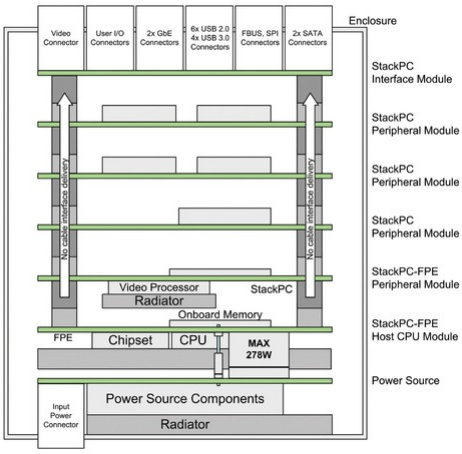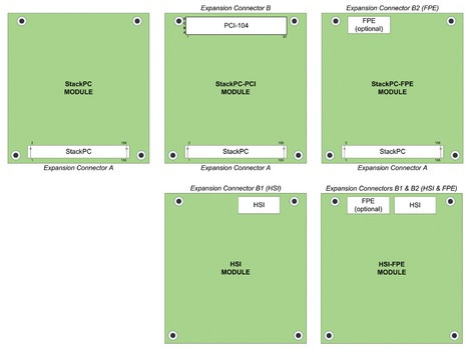StackPC: Better performance, more flexibility
The StackPC standard keeps stackable architectures growing with the addition of high-performance interfaces and the maintenance of backwards compatibility.
Pavel Shamsutdinov
FASTWEL Group Co. Ltd.
Draft of the proposed StackPC standard designed by Fastwel has been submitted to the PC/104 Consortium and is currently under review by its technical committee. The StackPC specification combines advantages of PC/104 specifications from the PC/104 Consortium and the family of Computer-On-Modules (COMs) from the PICMG Consortium.
Current embedded systems based on ISA or PCI bus stacks used in PC/104, PC/104-Plus, and PCI-104 types of modules have lost their competitive edge against other high-performance solutions for the majority of modern technical applications. Moreover, most of the newest chipsets for modern processor platforms do not include PCI bus support. Nevertheless, the PC/104 form factor remains attractive for a wide range of applications such as onboard systems, robotics, pilotless vehicles, and industrial automation – where the size to performance ratio matters. The adaptation of the PC/104 specification to present-day requirements by adding PCI Express, SATA, USB, and other high-performance interfaces is the next logical step for the form factor.
Updating the interface
Due to its compact size, the PC/104 form factor, coupled with the continuous growth of feature sets, presents some difficulties in the placement of necessary components and sufficient numbers of standard input/output connectors in state-of-the-art computer or add-on modules. It is also important to note that PC/104 modules are mostly designed for operation in harsh environments and require installation inside an enclosure to protect them from mechanical, electromagnetic, or environmental impacts. Therefore, embedded systems manufacturers often have to bring all interfaces from the CPU or expansion boards to the front panel of an enclosure using flat cables and, most of the time, unshrouded pin headers.
One way to avoid this potentially unsafe and inconvenient practice is to aggregate the main set of input/output interfaces in stack connectors. The absence of cabling inside an enclosure improves convection, noise immunity and durability, reduces conducted emissions, and, consequently, increases system effectiveness and reliability. Interfaces combined in stack connectors can be brought to the front panel of the enclosure using an inexpensive and efficient solution: a terminal interface module carrying the necessary set of standard interface connectors, which is implemented in the StackPC standard.
Like other modules from the PC/104 family, the StackPC system does not require an expensive backplane; it is self-sufficient, only requiring a main power supply and connecting the necessary peripheral devices (Figure 1).

Figure 1: The StackPC system in an individual enclosure.
StackPC defines a new standard for stackable modular architectures based on modern highbandwidth serial interconnects such as PCI Express with x1/x4/x8/x16 links, SATA, USB 2.0, USB 3.0, Gigabit Ethernet, and DisplayPort, as well as LPC, SPI, SMBus, and others used to provide support for low-bandwidth interconnects. Additionally, StackPC provides support for the legacy 32-bit 33 MHz PCI bus to preserve PCI/104, PC/104-Plus, and PCI/104-Express module compatibility, making it a powerful yet flexible solution for modern computer and high-speed data-acquisition systems.
StackPC configurations
There are five configurations of StackPC modules. All configurations are mechanically and electrically compatible with each other but the set of supported interfaces differs. The configurations are: StackPC, StackPC-PCI, StackPC-FPE, HSI, HSI-FPE (Figure 2).

Figure 2: Basic view of possible StackPC layouts.
The StackPC specification defines the following types of stack connectors: StackPC, PCI-104, HSI, and FPE. The StackPC connector is identical to the PCI/104-Express connector defined in the PCI/104-Express and PCIe/104 specifications by the PC/104 Consortium. The PCI Express connector was designed for the PC/104 Consortium to match the PC/104 standard 0.600" (15.24 mm) stack height and standoff tolerances. It was tested to ensure it met the PC/104 durability and PCI Express signal integrity requirements.
HSI and FPE connectors in the StackPC-FPE, HSI, and HSI-FPE configurations are based on the SEAF/SEAM series connectors from Samtec’s High Speed/High Density Open Pin Field connectors, and are suitable for StackPC stack organization with high-speed interface support. Currently their usage concerning the appropriate certification and qualification tests for stackable PCIe and SATA interconnects is under review.
Different, but not too different
The PCI-104 connector is electrically and mechanically identical to the PCI connector defined in the PC/104 Consortium’s PC/104-Plus specification. The main difference between StackPC-PCI and PC/104-Plus is that the PC/104 connector containing the outdated ISA bus is replaced with a high-density connector, which incorporates a set of the most up-to-date interfaces:
- Four PCIe x1 links for high-speed interconnects with various add-on cards (communication, storage, video input/output, etc.)
- Six USB 2.0 ports for high-speed serial communication or mass storage devices
- Two SATA ports for modern and high-performance storage systems
- Two Gigabit Ethernet ports for industry-standard high-bandwidth communication
- LPC bus for low-bandwidth serial and parallel communications and other input/output equipment
- SPI interface with three slave select lines to provide support for analog/discrete data-acquisition embedded systems or nonvolatile memory
- SMBus interface for various I2C-compatible sensors and service information reading from add-on cards
- Two Fieldbus (FBUS) ports, CAN 2.0, or RS-485 with auto-direction support for RS-485 communication
- 3 V RTC battery support
Additionally, the new connector occupies less board space than the standard PC/104 connector, which allows more components to be placed onboard and adds more functionality to StackPC modules.
Compared to PCI/104-Express Type 1 modules, the PCIe x16 link in StackPC and StackPC-PCI modules has been changed to the following set of interfaces: SATA (2 ports), USB 2.0 (6 ports), Gigabit Ethernet (2 ports), LPC, SPI (3 slave select lines), and Fieldbus interfaces (2 CAN 2.0 or RS-485 ports), which affects only PCI Express x16 peripheral/multimedia cards. To prevent damage due to the improper stacking of different types of modules, there is a special type detection mechanism that ensures the power supply is switched off in case the wrong modules are combined.
HSI usage helps further save board space while providing almost the same interface set compared to the StackPC module plus four USB 3.0 ports. FPE extension provides an additional PCI Express x16 link (or two SDVO) and a DisplayPort interface for multimedia cards.
StackPC modules maintain mechanical backward compatibility and bridging to PCI/104, PC/104-Plus, and PC/104 to provide support for existing products and solutions. Using StackPC modules together with special adapters maintains compatibility with all PC/104 family modules while making it possible to implement high-bandwidth solutions and modern processor platforms (see Table 1 for a full comparison between the StackPC and PC/104 specifications).
| PC/104-Plus |
PC/104 Type1 |
PC/104 Type2 |
StackPC |
StackPC PCI |
StackPC FPE |
HSI | HSI-FPE | |
| ISA | 1 | - | - | - | - | - | - | - |
| PCI | 4 slots | - | - | - | 4 slots | - | - | - |
| PCIe x1 | - | 4 | 4 | 4 | 4 | 4 | 4 | 4 |
| PCIe x4 | - | - | 2 | 1 | 1 | 1 | 1 | 1 |
|
PCIe x16or 2x SDVO |
- | 1 | - | - | - | 1 | - | 1 |
| USB 2.0 | - | 2 | 2 | 6 | 6 | 6 | 6 | 6 |
| USB 3.0 | - | - | - | - | - | - | 4 | 4 |
| SATA | - | - | 2 | 2 | 2 | 2 | 2 | 2 |
| GbE | - | - | - | 2 | 2 | 2 | 2 | 2 |
| LPC | - | - | 1 | 1 | 1 | 1 | 1 | 1 |
| SPI | - | - | - | 3 | 3 | 3 | 3 | 3 |
| SMBus | - | 1 | 1 | 1 | 1 | 1 | 1 | 1 |
| RTC Battery | - | - | 1 | 1 | 1 | 1 | 1 | 1 |
| Other | - | - | - |
2x CAN or 2x RS-485 2 Express Cards |
2x CAN or 2x RS-485 2 Express Cards |
2x CAN or 2x RS-485 DisplayPort 2 Express Cards |
- | DisplayPort |
The connector replacements can extend PC/104’s lifetime by giving it the new interface set necessary to build high-performance embedded systems capable of meeting modern technical requirements and withstanding competition among a variety of different form factors available on the embedded systems market. The industry-standard PCI Express bus used in StackPC provides as high-bandwidth a solution for embedded systems as video processing, fast data processing and encrypting, high-speed communication, and storage using standard PCIe-based solutions widely available from a variety of manufactures. At the same time, the legacy 32-bit PCI bus and PC/104 bridging capabilities provide access to a wide range of existing and fieldproven products. StackPC also provides several communication and industry-standard buses and interfaces, such as SATA, USB, Gigabit Ethernet, LPC, and SPI, which are necessary to build a complete, high-performance data-acquisition system that is reliable, less expensive, and more efficient.
Pavel Shamsutdinov is (Senior) Electronics Hardware Design Engineer at FASTWEL Group Co. Ltd.
FASTWEL Group Co. Ltd. info@fastwel.com www.fastwel.com